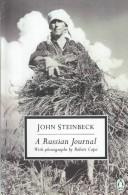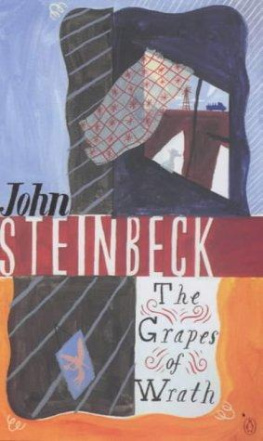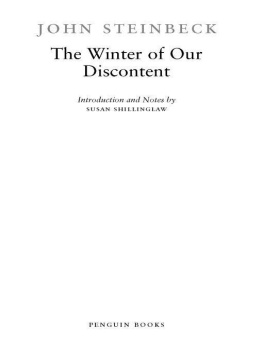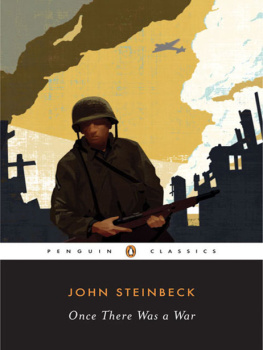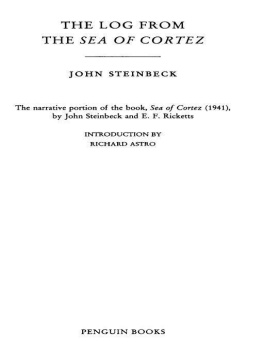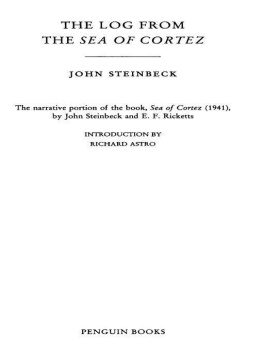PENGUIN BOOKS
A Russian Journal
Born in Salinas, California, in 1902, John Steinbeck grew up in a fertile agricultural valley about twenty-five miles from the Pacific Coast - and both valley and coast would serve as settings for some of his best fiction. In 1919 he went to Stanford University, where he intermittently enrolled in literature and writing courses until he left in 1925 without taking a degree. During the next five years he supported himself as a labourer and journalist in New York City, all the time working on his first novel, Cup of Gold (1929). After marriage and a move to Pacific Grove, he published two Californian fictions, The Pastures of Heaven (1932) and To a God Unknown (1933), and worked on short stories later collected in TheLong Valley (1938). Popular success and financial security came only with Tortilla Flat (1935), stories about Monterey's paisanos. A ceaseless experimenter throughout his career, Steinbeck changed courses regularly. Three powerful novels of the late 1930s focused on the Californian labouring class: In Dubious Battle (1936), Of Mice and Men (1937), and the book considered by many his finest, The Grapes of Wrath (1939). Early in the 1940s, Steinbeck became a filmmaker with The Forgotten Village (1941) and a serious student of marine biology with Sea of Cortez (1941). He devoted his services to the war, writing Bombs Away (1942) and the controversial play-novelette The Moon is Down (1942). Cannery Row (1945), The Wayward Bus (1947), The Pearl (1947), A Russian Journal (1948), another experimental drama, BurningBright (1950), and The Log from the Sea of Cortez (1951) preceded publication of the monumental East of Eden (1952), an ambitious saga of the Salinas Valley and his own family's history. The last decades of his life were spent in New York City and Sag Harbor with his third wife, with whom he travelled widely. Later books include Sweet Thursday (1954), TheShort Reign of Pippin IV: A Fabrication (1957), Once There Was a War (1958), The Winter of Our Discontent (1961), Travels with Charley in Search of America (1962), America and Americans (1966), and the posthumously published Journal of a Novel: The East of Eden Letters (1969), Viva Zapata! (1975), The Acts of King Arthur and His Noble Knights (1976), and Working Days: The Journals o/The Grapes of Wrath (1989). He died in 1968, having won a Nobel Prize in 1962.
Born Endre Erno Friedmann in Budapest, Hungary, on October 22,1913, the self-styled Robert Capa became one of the most celebrated war photojournalists of the twentieth century. He left Hungary at seventeen and, until he died in 1954
killed by a landmine in Indochina - he roamed the world photographing war. With his beloved companion, photographer Gerda Taro (killed in 1937), he first saw action during the Spanish Civil War, where his emphatic portraits of human anguish won him international acclaim. In 1938 he travelled to China and witnessed the Japanese invasion; he covered World War II, Israel in 1948, and Indochina in 1954. During his life he published five photographic texts: Death in theMaking (photographs by Robert Capa and Gerda Taro, 1938); The Battle of Waterloo Road (text by Diana Forbes-Robertson and photographs by Capa, 1941); Slightly Out of Focus (1947); A Russian Journal (1948); and Report'on Israel (text by Irving Shaw and photographs by Capa).
Susan Shillinglaw is a professor of English and director of the Center for Steinbeck Studies at San Jose State University.
She co-edited Steinbeck and the Environment and John Steinbeck: Contemporary Reviews. She edits the SteinbeckNewsletter and has published articles on Steinbeck.
JOHN STEINBECK
A Russian Journal
With photographs by Robert Capa With an Introduction by Susan Shillinglaw PENGUIN BOOKS
Published by the Penguin Group
Penguin Books Ltd, 80 Strand, London, WC2R ORL, England Penguin Putnam Inc., 375 Hudson Street, New York, New York 10014, USA Penguin Books Australia Ltd, Ringwood, Victoria, Australia
Penguin Books Canada Ltd, 10 Alcorn Avenue, Toronto, Ontario, Canada M4V 3B2 Penguin Books India (P) Ltd, 11, Community Centre, Panchsheel Park, New Delhi - 110 017, India
Penguin Books (NZ) Ltd, Private Bag 102902, NSMC, Auckland, New Zealand Penguin Books (South Africa) (Pty) Ltd, 5 Watkins Street, Denver Ext 4, Johannesburg 2094, South Africa
Penguin Books Ltd, Registered Offices: 80 Strand, London, WC2R ORL, England First published in the United States of America by The Viking Press, Inc. 1948
This edition with an Introduction by Susan Shillinglaw published in Penguin Books 1999
Reprinted in Penguin Classics 2000
Copyright John Steinbeck, 1948
Copyright renewed Elaine Steinbeck, Thorn Steinbeck, and John Steinbeck IV, 1976
Introduction copyright Susan Shillinglaw, 1999
All rights reserved
Parts of this book appeared in the New York Herald Tribune and other newspapers.
Photographs on pages 72, 80, 95,151, Copyright 1948 by The Curtts Publishing Company.
Set in Garamond Printed in Great Britain by Antony Rowe Ltd, Chippenhafn, Wiltshire Except in the United States of America, this book is sold subject
to the condition that it shall not, by way of trade or otherwise, be lent, re-sold, hired out, or otherwise circulated without the publisher's prior consent in any form of binding or cover other than that in
which it is published and without a similar condition including this condition being imposed on the subsequent purchaser
ISBN 9780141186337
INTRODUCTION
IN 1946, WINSTON CHURCHILL announced that an "Iron Curtain" I had been drawn closed across Eastern Europe. In the winter of 1947, the cold war began in earnest. The Soviet Union, fierce ally of 1 the United States in World War II, had become a menacing presence, a foe barely understood. "In the papers every day," John Steinbeck begins his text, "there were thousands of words about Russia," and yet, he continues,
"there were some things that nobody wrote about Russia, and these were the things that interested us most of all." His quest, and that of photographer Robert Capa who accompanied him, was to discover the "great other side," the "private life of the Russian people." Steinbeck and Capa's modest book about the lives of Russians, ARussian Journal, published in 1948, attempts only "honest reporting, to set down what we saw and heard without editorial comment, without drawing conclusions about things we didn't know sufficiently."
In many ways, that is what John Steinbeck had been doing quite successfully for twenty years, writing books about ordinary people: paisanos, Oklahoma migrants, enlisted men in World War II, Mexican peasants. ARussian Journal does not sound the epic chords of I The Grapes of Wrath, certainly, but it has some of that book's empathy and humanity. Indeed, one explanation for the appeal of A 1 Russian Journal is that this book, unlike so many other accounts of I Russia published at the time, engages and informs in Steinbeck's I most characteristic manner: expressing empathy and understanding I for working people; capturing with a journalist's eye the telling de-1 tail; seeing "nonteleologically," recording merely what is witnessed; 1 and finally leavening the narrative with a wry humor absent in I many more ponderous contemporary accounts of travel through I Soviet-approved locales. If not the most erudite or wide-ranging I book about postwar Russia, Steinbeck and Capa's is just what they claimed for it: "It is not the Russian story, but simply
Next page
